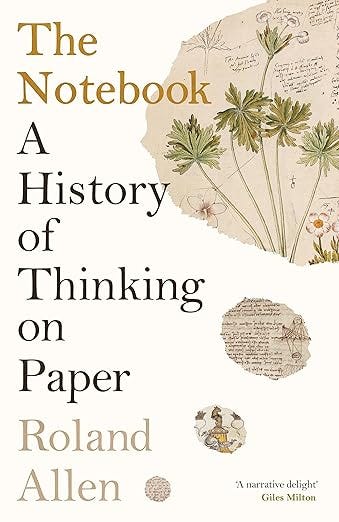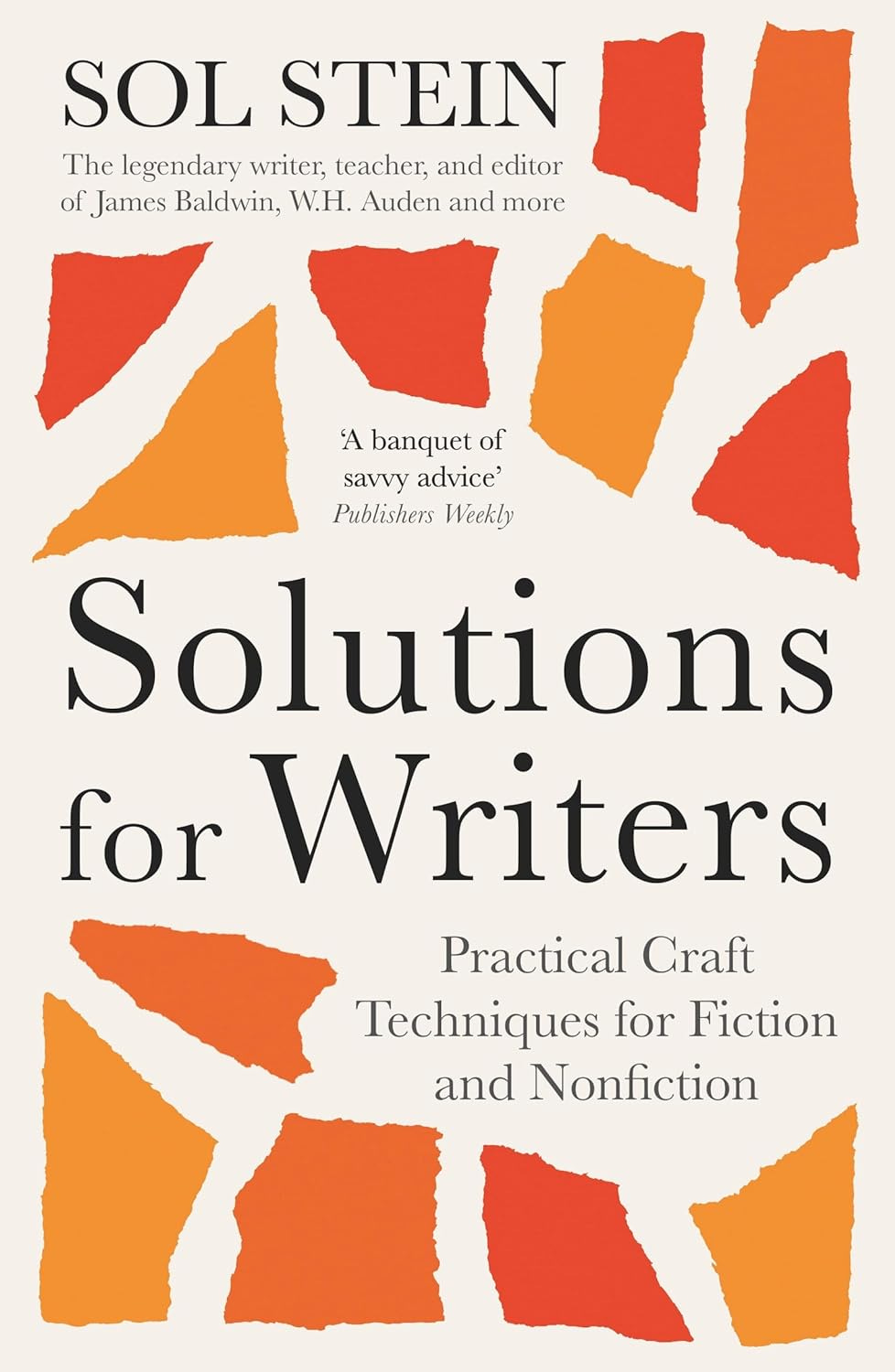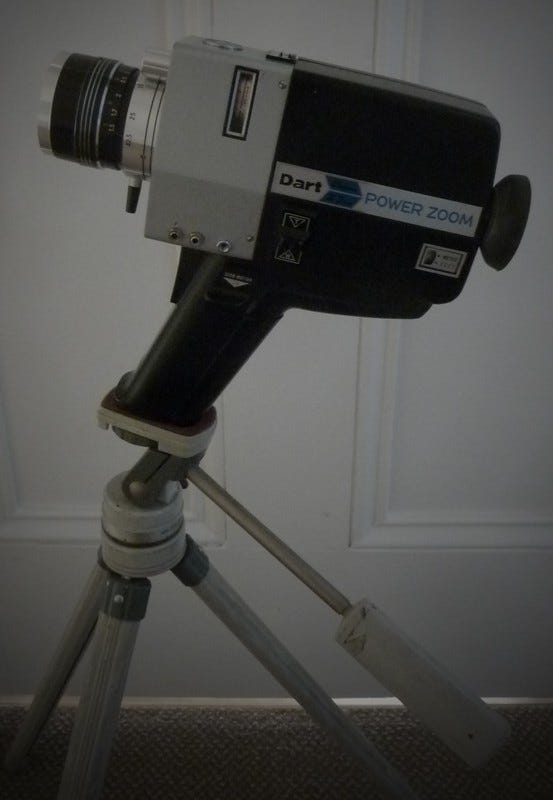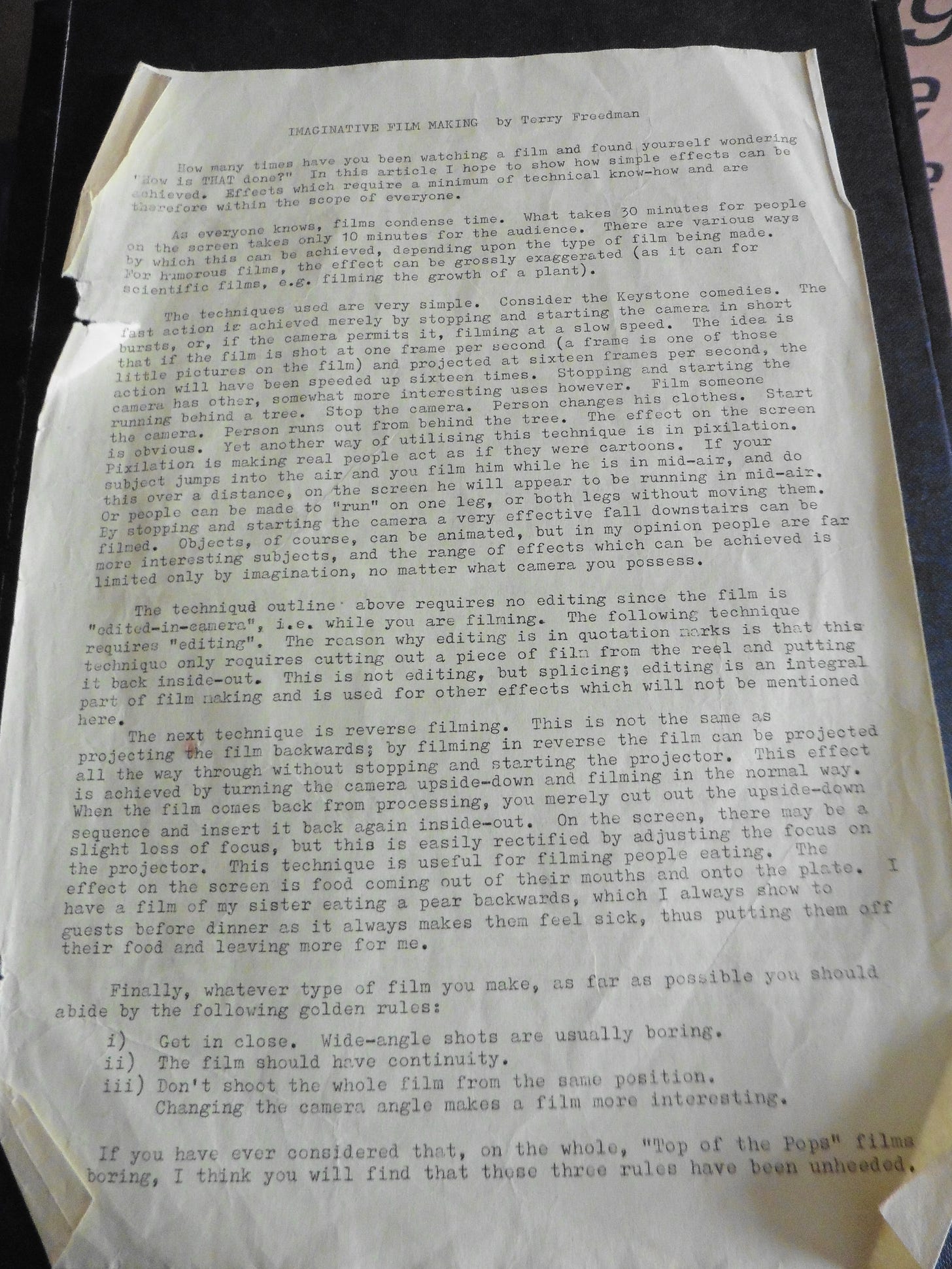Greetings!
Sorry this is a bit later than usual. Explanations below. This week I’m looking at the heat, 9/11, two books I’ve just received for review, film-making from fifty years ago and a couple of shout-outs.
But enough of this persiflage! On with the newsletter!
Too hot
Let’s start with the traditional English moan about the weather. It’s too hot! There was a thunderstorm yesterday and half an hour later there was no sign that it had ever been raining.
Because of this, the Freedman Word Factory has slowed right down. The ideas are there, but getting them down in any kind of sensible way has been like wading through treacle. I’ve never waded through treacle, but I imagine that this is what it’s like.
Anyway, here’s Anthony Strong moaning about it too. I quite like this video because it is completely bonkers. Don’t believe me? Check out the settings.
9/11
I’ve seen hardly any coverage of 9/11. On Substack,
discusses the way in which it is remembered, or rather perceived, by people who were not yet alive at the time. He writes:Our priest yesterday quoted a four year old-- "September 11? Oh, that means they're going to show the planes again." We study the artifacts, the outcomes of events, but nothing recaptures the human gut-kick of living through it.
I think it’s easier to think about large events in the details rather than the big picture. For example, six million Jews were murdered in the Holocaust, but that number is too big for me to conceive. A few days ago I learnt of a 12 year old girl who was sent to Auschwitz and killed there, and I thought to myself, “Who murders a child?”
The pictures of the planes crashing into the towers are still very vivid for me. But what makes a bigger, or perhaps I should say more personal or deeper impact, are the recordings of people on the planes, the recording of a reporter saying “Oh my goodness, Oh my goodness”, the photo of a fireman with tears streaming down his face, the lines of people looking at posters of missing people.
This small article is my response to
’s imploring people to speak. She writes:Make something on 9/11.
If you're a bricklayer, place a brick in its right place in a building on 9/11; if you’re an accountant, place the sum as the right answer on 9/11; if you're a bartender, make the perfect cocktail, set it down with your hand in front of your customer—and connect on 9/11.
Books received
It’s funny how things work out. Today’s issue of Start the Week was delayed because I had a very broken up sleep, because of the heat. Having a cat lying on top of me for some of the night did nothing to help matters. This morning I went to a cafe to write this, but the wifi kept cutting out, and two young men were catching up with each other at full volume. In the end I gave up and sat in a park to read.
However, had I managed to publish this newsletter earlier I wouldn’t have been able to include a mention of these two books that were waiting for me when I arrived home.
Obviously, I haven’t had time to read them yet (I’m a fast reader but not that fast), but I have glanced through and am in a position to say a few words by way of a precursor to a full review.
The Notebook

This comes out on 2nd November. It has a very readable style, and interestingly the footnotes are in a different font from, and bigger than, the main text.
So far I’ve learnt the following:
How did Chaucer manage to write stories based on the work of Boccaccio shortly after Boccaccio had written them, in an age before mass communication? It’s a good question, one that had never occurred to me before. Apparently, the stories were brought from one place to another via trade routes. It’s kind of obvious once it’s pointed out.
Moleskine books were (and perhaps still are) regarded as a status symbol. I wasn’t aware of that, but two of my accessories while working in a proper job were, along with a suit/jacket and tie and, indubitably, double cuffed shirt with cufflinks, a Moleskine notebook and fountain pen!
Finally (for now) — and this is another thing that hadn’t occurred to me — some people regard the notebook as a kind of Oulipian object. The Oulipo is based on constraints, and a notebook is in effect a physical embodiment of that idea.
The publisher is Profile Books.
Solutions for writers
This was published last week on 7th September. It is packed with useful information. I’m especially looking forward to reading the the sections called How to Show Instead of Tell, and Using the Techniques of Fiction to Enhance Nonfiction. I’m a great advocate of using fictional techniques in nonfiction, which is why I like the so-called New Journalism. For an excellent example of this, read Frank Sinatra has a cold, by Gay Talese.
“Solutions” is published by Souvenir Press, which is an imprint of Profile Books.
Imaginative film making
The following article was written and published in May 1973. I thought you might find it interesting, as it looks at a few imaginative ways in which to make films — with a cine camera and actual film! Most of the techniques described can still be achieved with video.
How many times have you been watching a film and found yourself wondering "How is that done?" In this article I hope to show how simple effects can be achieved. Effects which require a minimum of technical know-how and are therefore within the scope of everyone.
As everyone knows, films condense time. What takes 30 minutes for people on the screen takes only 10 minutes for the audience. There are various ways by which this can be achieved, depending upon the type of film being made.
For humorous films, the effect can be grossly exaggerated (as it can for scientific films, e.g. filming the growth of a plant). The techniques used are very simple. Consider the Keystone comedies. The fast action is achieved merely by stopping and starting the camera in short bursts, or, if the camera permits it, filming at a slow speed1. The idea is that if the film is shot at one frame per second (a frame is one of those little pictures on the film) and projected at sixteen frames per second, the action will have been speeded up sixteen times.
Stopping and starting the camera has other, somewhat more interesting uses however. Film someone running behind tree. Stop the camera. Person changes his clothes. Start the camera. Person runs out from behind the tree. The effect on the screen is obvious.
Yet another way of utilising this technique is in pixilation. Pixilation is making real people act as if they were cartoons. If your subject jumps into the air and you film him while he is in mid-air, and do this over a distance, on the screen he will appear to be running in mid-air. Or people can be made to "run" on one leg, or both legs without moving them.
By stopping and starting the camera, a very effective fall downstairs can be filmed.
Objects, of course, can be animated, but in my opinion people are far more interesting subjects, and the range of effects which can be achieved is limited only by imagination, no matter what camera you possess.
The techniques outlined above require no editing since the film is "edited-in-camera", i.e. while you are filming. The following technique does require "editing".
The reason that editing is in quotation marks is that this technique only requires cutting out a piece of film from the reel and putting it back inside-out. This is not editing, but splicing; editing is an integral part of film making and is used for other effects which will not be mentioned here.
The technique is reverse filming. This is not the same as projecting the film backwards; by filming in reverse the film can be projected all the way through without stopping and starting the projector. This effect is achieved by turning the camera upside-down and filming in the normal way. When the film comes back from processing, you merely cut out the upside-down sequence and insert it back again inside-out. On the screen, there may be a slight loss of focus, but this is easily rectified by adjusting the focus on the projector.
This technique is useful for filming people eating. The effect on the screen is food coming out of their mouths and onto the plate. I have a film of my sister eating a pear backwards, which I always show to guests before dinner as it always makes them feel sick, thus putting them off their food and leaving more for me.
Finally, whatever type of film you make, as far as possible you should abide by the following golden rules:
i) Get in close. Wide-angle shots are usually boring.
ii) The film should have continuity2.
iii) Don't shoot the whole film from the same position. Changing the camera angle makes a film more interesting.
If you have ever considered that, on the whole, "Top of the Pops" films boring, I think you will find that these three rules have been unheeded.
The text of that article was taken from a copy of a published magazine from 1973. The magazine didn’t stand the test of time very well, although it could have been in a worse state I suppose. Here’s what the page looks like:
I made a few minor amendments to the text, but apart from that small amount of editing nothing has been changed. I extracted the text from a photo in no time at all. I’ll explain the process in the next issue of my paid newsletter.
Shout-outs
Congrats to
who managed to run 5k within the time limit. A remarkable achievement, and well-deserved given how much preparation she did. I tried to convince her to take a bus some of the way like I did on cross-country runs, but she wouldn’t listen. Read the full gory details: has rewritten a story called The Room. It has a very Twilight Zone feel in my opinion. Interestingly, Sharron enlisted the advice of a couple of writers to help her improve on the original. She writes:Thank you to Meg Oolders Stock Fiction , Jim Cummings All Day Long , and Jim Sarasu Against Mundanefor offering me assistance with the significant revision of this short tale.
I already subscribe to All Day Long, and I will be checking out the other two that Sharron mentions. Kudos to Sharron for seeking help in this way. I’ve had a few unpleasant experiences when I’ve sought the views of other (amateur) writers — not here on Substack though.
Recent writing
My most recent experiment in style was in the form of a very unassertive person. I used to be very unassertive. I went on a course once, a weekend thing where you’re supposed to end up attracting friends and wealth and good fortune. I happened to mention to someone on the second day that it might be working because of an experience I had on the way home. He told the facilitators and they urged me to get up on stage and address the throng. I told them:
On the train home last night, someone started a conversation with me, another person asked me if I had a light, and someone else smiled at me. All I wanted was to be left alone to read my book, How To Win Friends and Influence People.
My delivery was a bit more interesting than that, more like my talk about the girl with long hair.
Well, everyone was in stitches and a girl I quite fancied came up to me afterwards and said:
You were a totally different person. Most of the time you walk around as if you’re seeking permission to breathe, but that was amazing.
Anyway, I only mention that because I’m a lot more assertive now but, hopefully, not an obnoxious idiot. Here’s the article, enjoy:
Experiments in Style: Unassertive
In my post for paid subscribers I wrote about how I overcame writers’ block.
In my next paid post I will be looking at how I extracted the text from a fifty year old mangled document, and one of the methods I use to organise myself.
And on Wednesday, if I can get my act together in time, I will be replying to Rebecca’s most recent letter to me. She and I have a great rapport, and you should definitely subscribe to hers and mine in order to enjoy our correspondence.
I hope you’ve enjoyed this newsletter and found it useful. Please subscribe, upgrade, leave a comment or share, or all of those things. Thanks for reading!
I bought a shutter release cable for my camera. That allowed me to take just one frame at a time.
For example, if someone is wearing a white jacket and then, a minute later, is wearing a blue jacket (because the second bit was filmed at a different time), there is a lack of continuity.









It may well be too darned hot, but Terry Freedman, you are too cool for school today! So many interesting topics for the start of this week. I want you to know I recognize how much thought and work you put into building these posts, and you never fail. Your shout out was such a delightful surprise, Terry. I saw that and I turned into an 8 year old with brand new shoes. It does not take much to thrill me! Thank you.
Great Start The Week Terry. Loved the Too Darn Hot video. Thank you for your thoughts on 911 and the link to Mary L Tabor's fine piece. Your Spark audio talk was simply hilarious--your British wit on full display.
Thanks for the mention in your comment on Sharron Bassano's "The Room." Yes, Sharron and I often send each other drafts of our works-in-progress for suggestions/critiques. She is the best friend I've never met and the only time she gets cross with me is when I say "lay" when I mean "Lie." I have found substack writers to be very generous and supportive.
Also, by all means subscribe to Meg Oolders and Jim Sarasu! They are both terrific